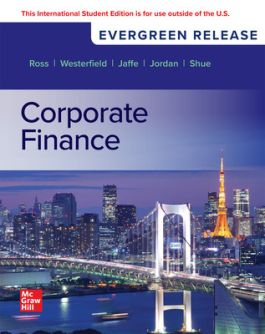Corporate Finance: 2025 Release ISE
1266961003
·
9781266961007
Corporate Finance, by Ross, Westerfield, Jaffe, Jordan, Shue, was written for the corporate finance course at the MBA level and the intermediate course in many undergraduate programs. The text emphasizes the modern fundamentals of the theory of finan…
Read More
PART ONE: OVERVIEW
1. Introduction to Corporate Finance
2. Financial Statements and Cash Flow
3. Financial Statements Analysis and Financial Models
PART TWO: VALUATION AND CAPITAL BUDGETING
4. Discounted Cash Flow Valuation
5. Net Present Value and Other Investment Rules
6. Making Capital Investment Decisions
7. Risk Analysis, Real Options, and Capital Budgeting
8. Interest Rates and Bond Valuation
9. Stock Valuation
PART THREE: RISK
10. Lessons from Market History
11. Return, Risk, and the Capital Asset Pricing Model
12. An Alternative View of Risk and Return
13. Risk, Cost of Capital, and Valuation
PART FOUR: CAPITAL STRUCTURE AND DIVIDEND POLICY
14. Efficient Capital Markets and Behavioral Challenges
15. Long-Term Financing
16. Capital Structure: Basic Concepts
17. Capital Structure: Limits to the Use of Debt
18. Valuation and Capital Budgeting for the Levered Firm
19. Dividends and Other Payouts
PART FIVE: LONG-TERM FINANCE
20. Raising Capital
21. Leasing
PART SIX: OPTIONS, FUTURES, AND CORPORATE FINANCE
22. Options and Corporate Finance
23. Options and Corporate Finance: Extensions and Applications
24. Warrants and Convertibles
25. Derivatives and Hedging Risk
PART SEVEN: SHORT-TERM FINANCE
26. Short-Term Finance and Planning
27. Cash Management
28. Credit and Inventory Management
PART EIGHT: SPECIAL TOPICS
29. Mergers, Acquisitions, and Divestitures
30. Financial Distress
31. International Corporate Finance
APPENDICES
Appendix A: Mathematical Tables
Appendix B: Solutions to Selected End-of-Chapter Problems
Appendix C: Using the HP-10B and TI BA II Plus Financial Calculators
1. Introduction to Corporate Finance
2. Financial Statements and Cash Flow
3. Financial Statements Analysis and Financial Models
PART TWO: VALUATION AND CAPITAL BUDGETING
4. Discounted Cash Flow Valuation
5. Net Present Value and Other Investment Rules
6. Making Capital Investment Decisions
7. Risk Analysis, Real Options, and Capital Budgeting
8. Interest Rates and Bond Valuation
9. Stock Valuation
PART THREE: RISK
10. Lessons from Market History
11. Return, Risk, and the Capital Asset Pricing Model
12. An Alternative View of Risk and Return
13. Risk, Cost of Capital, and Valuation
PART FOUR: CAPITAL STRUCTURE AND DIVIDEND POLICY
14. Efficient Capital Markets and Behavioral Challenges
15. Long-Term Financing
16. Capital Structure: Basic Concepts
17. Capital Structure: Limits to the Use of Debt
18. Valuation and Capital Budgeting for the Levered Firm
19. Dividends and Other Payouts
PART FIVE: LONG-TERM FINANCE
20. Raising Capital
21. Leasing
PART SIX: OPTIONS, FUTURES, AND CORPORATE FINANCE
22. Options and Corporate Finance
23. Options and Corporate Finance: Extensions and Applications
24. Warrants and Convertibles
25. Derivatives and Hedging Risk
PART SEVEN: SHORT-TERM FINANCE
26. Short-Term Finance and Planning
27. Cash Management
28. Credit and Inventory Management
PART EIGHT: SPECIAL TOPICS
29. Mergers, Acquisitions, and Divestitures
30. Financial Distress
31. International Corporate Finance
APPENDICES
Appendix A: Mathematical Tables
Appendix B: Solutions to Selected End-of-Chapter Problems
Appendix C: Using the HP-10B and TI BA II Plus Financial Calculators
Corporate Finance, by Ross, Westerfield, Jaffe, Jordan, Shue, was written for the corporate finance course at the MBA level and the intermediate course in many undergraduate programs. The text emphasizes the modern fundamentals of the theory of finance while providing contemporary examples to make the theory come to life. The authors aim to present corporate finance as the working of a small number of integrated and powerful intuitions rather than a collection of unrelated topics. They develop the central concepts of modern finance: arbitrage, net present value, efficient markets, agency theory, options, and the trade-off between risk and return, and use them to explain corporate finance with a balance of theory and application.

